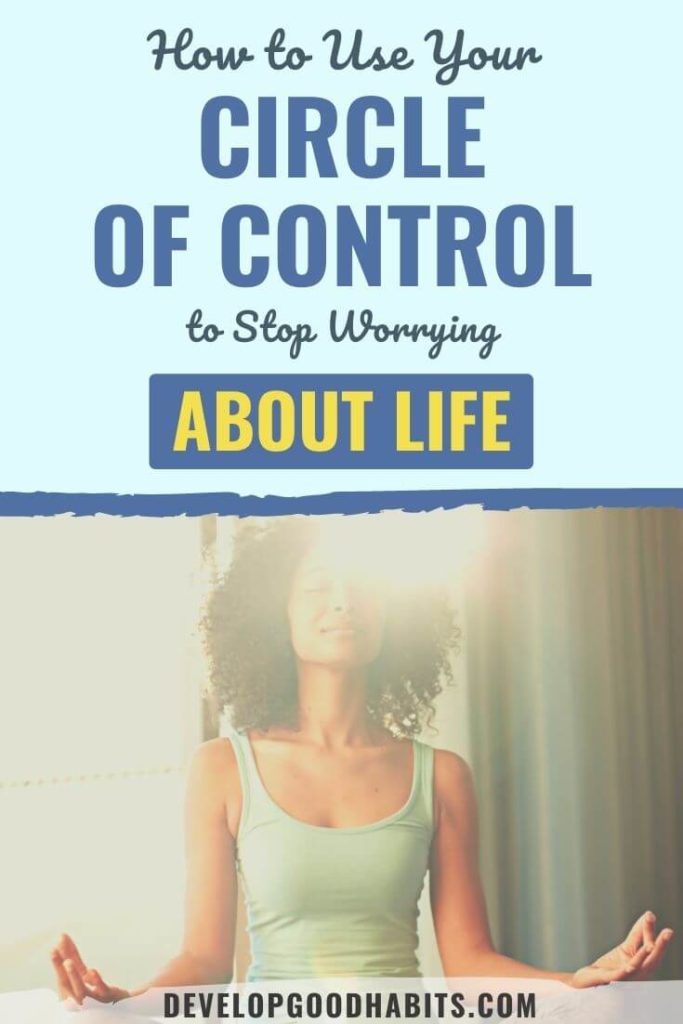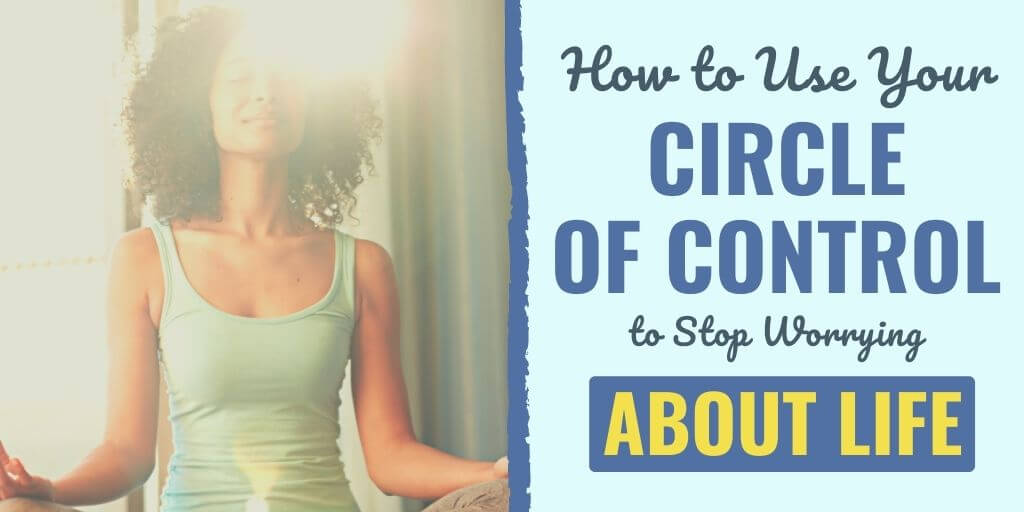There might be affiliate links on this page, which means we get a small commission of anything you buy. As an Amazon Associate we earn from qualifying purchases. Please do your own research before making any online purchase.
No matter who we are or what we do, we all desire to be in control of situations and circumstances that affect our daily lives. We do this because we wish to experience an outcome that significantly benefits us.
We would all agree that unmet expectations are the destination that we all seek to avoid. Still, we must admit, we wouldn't seek control so badly if we had not been in a situation where the outcome didn't end as we had hoped.
Our desire is to avoid repeat moments of disappointment, stress, frustration, and anger that come with a disappointing experience. However, many times, the things we seek to manipulate to get the end result we desire are out of our control. In this article you will receive helpful information on how to stop worrying so much and start to live an enjoyable life, using the “Circle of Control”.
What is the Circle of Control?
The circle of control was introduced by author and educator Stephen R. Covey. It demonstrates a representation of things we can actually do something about (control), influence, or things beyond our ability to influence.
For instance, on a sunny day, we can't control the weather, but we show control by choosing to wear a pair of sunglasses to protect our eyes from the sun. Similarly, we cannot control the rain, but we can control whether or not to carry an umbrella so that we don’t get soaking wet.
Stephen Covey’s Circle of Control is broken down into 3 parts:
- Circle of Control – things we can directly control.
- Circle of Influence – the concerns we can do something about. We have indirect control over those things.
- Circle of Concern – those things we have no control over.
We should invest our time and energy in the first two circles. The circle of control influences our thoughts, moods, reactions, mindset, attitude, and work ethic. We can control those things.
We should also invest our time and energy in our Circle of Influence. This circle determines who or what we have indirect control over. For instance, our commitments, productivity at work, our children’s future, our reputation, who we vote for, or who follows us on social media, are all under our indirect control. These are all concerns we can do something about. For more information see read discoveryinaction.com – Circle of Control.
We have all met individuals who were stressed over things they could control, and to those people, we often say, “If you want things to change, do something about it, fix it, and change it.” However, we have also found ourselves at some point worried about things outside of our control and influence.

The thoughts of “what if” and fear can overwhelm us if we allow them to. People are in an uproar and afraid of the pandemic, rumors of wars, the economy, the weather, death, or sporting events. All of which are considered in our Circle of Concern.
When we focus on concerns outside of our influence, we increase our stress and fall into accusations, worry, anger, and even victimization.
There was a biblical story of a man named Jacob who worked seven years for a lady’s hand in marriage. Her name was Rachel. She was unbelievably beautiful and had a figure that really attracted his attention. Jacob loved her so much that seven years seemed like a short time to work.
After seven years, Jacob was ready to marry the love of his life. However, he was drunk on his wedding night. As he went into his tent to enjoy his wife for the night, he didn't realize that he was actually joining himself to Rachel's older sister Leah. According to custom, Leah became his wife. Jacob hated Leah a long time because of it.
Many of us are like Jacob. We work hard every day to obtain Rachel (beautiful situations) in life. Still, sometimes we wake up to Leah (problems we hate that are out of our control). Those things happen in life but aren’t the end of the world. Therefore, we must learn to manage our worries, anger and resentment.
Why Is It So Important to Manage our Worry?
Failure to manage worry and stress can take its toll on our minds and our bodies.
There is no rule to say that we shouldn't worry or be stressed at all, but to be overly stressed or living life without managing it has been known to have adverse effects.
For instance, worry and stress make blood sugar levels spike, causing feelings of nausea, shortness of breath, fatigue, dizziness, muscle aches, inability to concentrate, headaches, nervous energy, and trembling or twitching. Check out this article to get more information on how worry and stress affect the body.
In addition, the flooding of stress hormones in the system can trigger short-term memory loss, heart attack, digestive disorders, and suppression of the immune system. Worry creates more problems than it solves and keeps us from enjoying life to the fullest.
Worry is caused by fear. Fear causes us to be mentally tormented, afflicted, plagued, aggravated, hassled, mistreated, and abused. That is not a life any of us desire to live.
So many of the things we stress over and worry about are making us sick physically and can make us mentally and emotionally unstable.
Fear leads from one thing to another. It leads to stress eating, causing weight gain, blood pressure problems, joint issues, diabetes, and more.
Worry and fear will have us crying one minute, then acting out the next. Also, these two emotions will have us running people out of our lives. Because no one wants to be around us when we have unpleasant attitudes and the dispositions that come with it.
Worry will have us running from things when nothing is chasing us. In addition, it will have us fearful of things that may never happen. Furthermore, anxiety and stress will cause us to lose sleep or have nightmares. We wake up tired as if we had no rest at all.
Making time for mindfulness meditation, prayer, and daily affirmations are practical techniques to overcome worry and stress. Each can help us gain and maintain the right mindset when it comes to things in our Circle of Control. Also, see these articles on 83 Simple Pleasures in Life That Can Brighten Your Day and 27 Gratitude Examples throughout Your Life so that you can proactively take control of your life and not let fear win.
Fear and worry cause us to always think the worst about situations. For example, not enjoying great times for fear that they will soon turn bad.

Have you ever met someone who was always negative? If not, may be you? But unfortunately, that negativity is usually found in the life of a person tormented because they haven't gotten over their fears. Fears of pain, hurt, rejection, and disappointment.
The Circle of Control helps our thought process when addressing those fears.
Fear can make us stagnant. It can paralyze us and keep us from having the faith to move forward in life. Mindfulness meditation gives us the ability to be present in the moment, so we don’t go through the motions in life, but have inner peace.
How often have we said we are “fixing to” do this or that? Our procrastination could be rooted in the soil of fear and worry. They whisper a million reasons for us not to act. Prayer gives us the faith to act and move forward in confidence instead of worry.
Don't let fear and worry stay! After a while, you will meet the other member of the fear family, regret.
Fear and worry often lead to regret. Regret will have us spending years saying, “I wish I would have.” Making daily affirmations help us boldly and confidently take on life’s challenges. No longer will we place our focus on the things that could upset us but, on our ability, to succeed in spite of.
A mid-19th century poet, Ralph Waldo Emerson, noted, “Fear defeats more people than any other one thing in the world.” Mindfulness, prayer, and positive affirmations partnered with the circle of control is a recipe for success.
A Step-by-Step Guide to using the Circle of Control to Reduce Stress and Anxiety in Life
Using the circle of control can be helpful to determine our course of action with any given circumstance. Therefore, helping us to have a positive mindset and less stress and worry in our lives. For example, we can reflect on situations and ask ourselves if this problem we're facing within our circle of control (where we can directly control it). Or is it within our circle of influence (where we can indirectly control it), or our circle of concern (where it is out of our control).
It may even be simpler to divide things up into two concepts, what we can control and what we can’t.
Things we can’t control:
Spending time worrying and stressing about those things will be a waste of time. It is better for our overall health to concern ourselves with things we can control.
Things we can control:
4 Ways to Use the Circle of Control to Remain Calm
Once we’ve categorized our concerns, we decide what we can take action on. From there, we act accordingly. If we can do something about it, let’s do it!
But if it falls out of our circle of control, we think positively about it as we:
1. Meditate
Getting our minds right concerning the situation. It helps us address stress therefore reducing areas of anxiety.
2. Pray
Calling on our hope in the Heavenlies. Putting our faith in God to help us in areas that are beyond our control. In addition, it lays ahold of His willingness to help us and brings us much peace that He is in control. Furthermore, it is a form of us letting go of our need for control.
3. Make Positive Affirmations
These give us the motivation we need to act on things we can control and to change negative thinking patterns.
4. Utilize Worksheets
Fill it in with your concerns, the things you can and can’t control.
You want to continue with those practices until you have peace about the problem, and it no longer feels like it's causing you stress.

There are printable worksheets available at the following links to help you balance where you place your energy.
- Circle of Control Job Aid
- Circle of Control Worksheet
- What Can I Control? (Free Worksheet!)
- Circles of Control Worksheet
- Circle of Control Printable
If you choose to use the worksheets personally, print two pages.
- Circle of Control
- Circle of Concern
Then…
- Make a list on each page of things you can control versus things you cannot
- Place the list of things you can control in a place where you feel you need to be reminded the most. For example, your desk at work or your mirror in the bathroom at home.
For teachers looking to do this activity with students. You may also want to:
- Print out sample pages (Circle of Control and Circle of Concern).
- It may be more fun for the class to draw a circle on a large piece of paper and label it “things we can control” (Circle of Control and Circle of Influence).
- Draw a circle on another piece of paper and label it “things we can’t control” (Circle of Concern).
- Explain to you students the meaning of each circle.
- Draw two circles on the board for the class to participate as a whole to gain a greater understanding.
- Help each student get started by having the whole class list things they can’t control like the weather, traffic, scores to sporting events, etc.
- Go over the circle of control, explaining and helping them list examples of things they can control in life.
- Afterwards, turn them loose to come up with a list on their own of each circle.
- Remind them to always put their effort and energy into things they can control and not stress over what they can’t.
Final thoughts on How to Use Your Circle of Control to Stop Worrying about Life
The circle of control is a brilliant tool to help us keep the proper perspective when facing life's obstacles. In addition, it also enables us to maintain control of ourselves so that we manage life's challenges healthily and productively.
The unexpected will come, but it matters the most how we handle it. For more on ways to help you maintain balance and strength in life, check out this article on 35 SMART Goals for all areas of your life.


